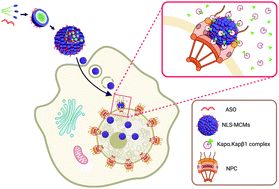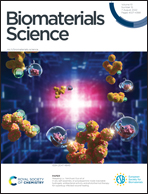A self-assembling peptidic platform to boost the cellular uptake and nuclear delivery of oligonucleotides†
Abstract
The design of non-viral vectors that efficiently deliver genetic materials into cells, in particular to the nucleus, remains a major challenge in gene therapy and vaccine development. To tackle the problems associated with cellular uptake and nuclear targeting, here we introduce a delivery platform based on the self-assembly of an amphiphilic peptide carrying an N-terminal KRKR sequence that functions as a nuclear localization signal (NLS). By means of a single-step self-assembly process, the amphiphilic peptides afford the generation of NLS-functionalized multicompartment micellar nanostructures that can embed various oligonucleotides between their individual compartments. Detailed physicochemical, cellular and ultrastructural analyses demonstrated that integrating an NLS in the hydrophilic domain of the peptide along with tuning its hydrophobic domain led to self-assembled DNA-loaded multicompartment micelles (MCMs) with enhanced cellular uptake and nuclear translocation. We showed that the nuclear targeting ensued via the NLS interaction with the nuclear transport receptors of the karyopherin family. Importantly, we observed that the treatment of MCF-7 cells with NLS-MCMs loaded with anti-BCL2 antisense oligonucleotides resulted in up to 86% knockdown of BCL2, an inhibitor of apoptosis that is overexpressed in more than half of all human cancers. We envision that this platform can be used to efficiently entrap and deliver diverse genetic payloads to the nucleus and find applications in basic research and biomedicine.



 Please wait while we load your content...
Please wait while we load your content...